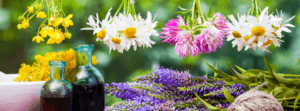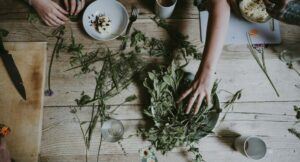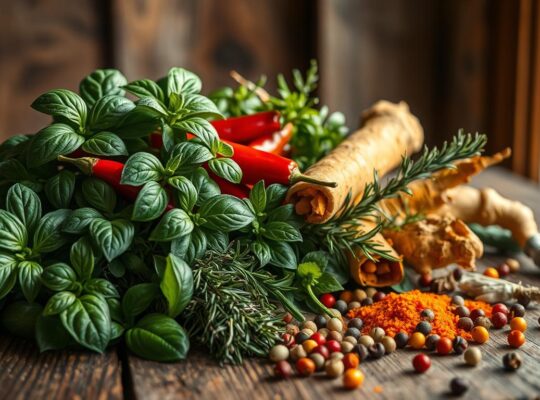Let’s do a little project – how about I guide you through the enchanting process of creating your very own herbal first aid kit. Whether you’re a seasoned green witch or just dipping your toes into the world of natural healing, this guide will help you harness the power of plants for everyday wellness. So, grab your favorite mug of herbal tea, and let’s dive in!
Introduction to Herbal First Aid Kits: Nature’s Medicine Cabinet
Alright, let’s start with the basics. Why go herbal when you can just grab a pre-made first aid kit from the store? Well, my friends, herbal remedies have been Mother Nature’s go-to healing tools for thousands of years. They’re not just gentle on your body; they’re also packed with powerful healing properties that can address a wide range of common ailments.
Now, don’t get me wrong – conventional first aid kits have their place. But an herbal kit can complement traditional medicine beautifully, offering a more holistic approach to healing. Plus, there’s something incredibly empowering about creating your own remedies!
Herbal medicine is rooted in ancient wisdom, with every culture having its own herbal traditions. From the healing practices of indigenous peoples to the sophisticated herbal systems of Traditional Chinese Medicine and Ayurveda, plants have been our allies in health for millennia.If you’re new to the world of herbal magic, you might want to check out my previous article on Top 10 Healing Herbs Every Witch Should Know. It’ll give you a great foundation for understanding some of the key players in herbal healing.
Essential Components of a Herbal First Aid Kit: Your Magical Toolkit
Now, let’s talk about what you’ll need in your herbal first aid kit. Think of it as assembling your magical toolkit!
Core Herbs and Their Purposes
- Calendula: Nature’s antiseptic, great for skin healing
- Echinacea: Immune system booster
- Lavender: Calming and great for minor burns
- Chamomile: Soothing for digestion and nerves
- Yarrow: Stops bleeding and fights infection
- Plantain: Nature’s band-aid, great for insect bites and stings
Required Tools and Containers
- Small glass jars for storing herbs and tinctures
- Cheesecloth for straining
- Mortar and pestle for grinding herbs
- Beeswax for making salves
- Carrier oils (like olive or coconut oil)
- Dropper bottles for tinctures
- Small spray bottles for herbal sprays
Labeling and Organizing
Organization is key when it comes to first aid! Label each item clearly with the herb name, date prepared, and intended use. You can use a small notebook or index cards to keep track of recipes and uses. Consider organizing your kit by ailment type (e.g., skin healing, digestive issues, pain relief) for easy access in times of need.
Herb Selection: Balancing Properties and Uses
Choosing the right herbs for your kit is like selecting the perfect ingredients for a magical potion. You want a balance of herbs that can address common ailments while also complementing each other.
Common Ailments and Corresponding Herbs
- Cuts and scrapes: Calendula, Plantain
- Digestive issues: Peppermint, Ginger
- Headaches: Feverfew, Willow bark
- Anxiety and stress: Lemon balm, Passionflower
- Colds and flu: Elderberry, Thyme
Herbal Forms: Tinctures, Salves, Powders, and Teas
Herbs can be prepared in various forms, each with its own benefits:
- Tinctures: Concentrated liquid extracts, great for quick absorption
- Salves: Topical ointments for skin issues
- Powders: Versatile form for internal or external use
- Teas: Gentle and soothing, perfect for digestive and nervous system support
Maximizing Shelf-life: Tips for Preservation
To keep your herbal remedies potent:
- Store in dark glass containers away from direct sunlight
- Keep in a cool, dry place
- Use alcohol-based tinctures for longer shelf life
- Rotate your stock regularly, using older preparations first
For more on working with herbs, check out The Green Witch’s Guide to Herbal Magick by Annabel Margaret. It’s a fantastic resource for deepening your herbal practice!
Creating Herbal Remedies: A Step-by-Step Guide
Now for the fun part – actually making your remedies!
Sterilization and Preparation of Tools
Always start with clean tools to prevent contamination:
- Wash all tools with hot, soapy water
- Rinse thoroughly
- Sterilize glass jars by boiling for 10 minutes
- Allow everything to air dry completely before use
Basic Recipes
Here’s a simple salve recipe to get you started:
Calendula Healing Salve
- 1 cup calendula-infused oil
- 1 oz beeswax
- 10 drops lavender essential oil (optional)
- Melt beeswax in a double boiler
- Add infused oil and stir until combined
- Remove from heat and add essential oil if using
- Pour into clean jars and let cool
Quality Control and Testing
Always test your remedies on a small area first to ensure effectiveness and check for any adverse reactions. Keep detailed notes on what works well and what might need tweaking.
Safety and Precautions in Herbal First Aid
While herbs are generally gentle, it’s important to use them responsibly.
Recognizing the Limits of Herbal Medicine
Herbal remedies are fantastic for minor ailments and first aid, but they’re not a substitute for professional medical care in serious situations. Always seek medical help for severe injuries, persistent symptoms, or if you’re unsure about a condition.
Allergy Considerations and Patch Testing
Before using any new herb, do a patch test:
- Apply a small amount of the herb or preparation to your inner forearm
- Cover with a bandage and wait 24 hours
- Check for any redness, itching, or irritation
Staying Informed
The world of herbal medicine is vast and always evolving. Stay curious and keep learning! Consult reputable sources, take classes, and don’t hesitate to consult with healthcare professionals, especially if you’re pregnant, nursing, or taking medications.
Conclusion: Your Magical First Aid Journey Begins
Creating your own herbal first aid kit is more than just assembling a bunch of plants – it’s about connecting with nature’s healing power and taking charge of your wellbeing. Remember, this kit is a reflection of you and your needs, so feel free to customize it as you learn and grow in your herbal practice.
As you embark on this magical journey of herbal healing, always approach it with respect, curiosity, and a dash of wonder. The plant world has so much to offer us if we’re willing to listen and learn.
Happy herb crafting, magical friends! May your first aid kit bring you health, healing, and a deeper connection to the natural world.
Blessed be, y’all! 🌿✨

FAQs
Q: Can I use fresh herbs in my first aid kit?
A: While fresh herbs are wonderful, dried herbs generally have a longer shelf life and are more practical for a first aid kit.
Q: How often should I replace the items in my herbal first aid kit?
A: It depends on the preparation, but generally, replace tinctures every 2-3 years, salves annually, and dried herbs every 6-12 months.
Q: Are there any herbs I should avoid if I’m pregnant?
A: Yes, many herbs can affect pregnancy. Always consult with a healthcare professional before using any herbs during pregnancy or while nursing.
Q: Can I use essential oils in my herbal first aid kit?
A: Essential oils can be a great addition, but use them cautiously as they’re very concentrated. Always dilute properly and research safe usage.
Q: How do I know if an herbal remedy is working?
A: Keep a journal of your symptoms and how they change with herbal use. If you don’t see improvement after a reasonable time, consult a healthcare professional.







